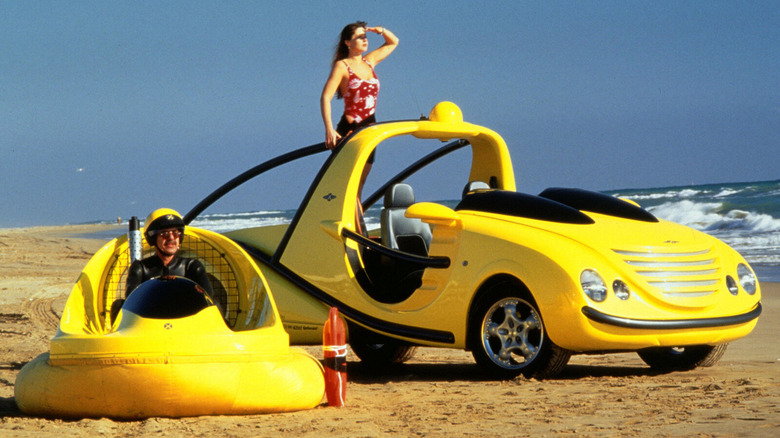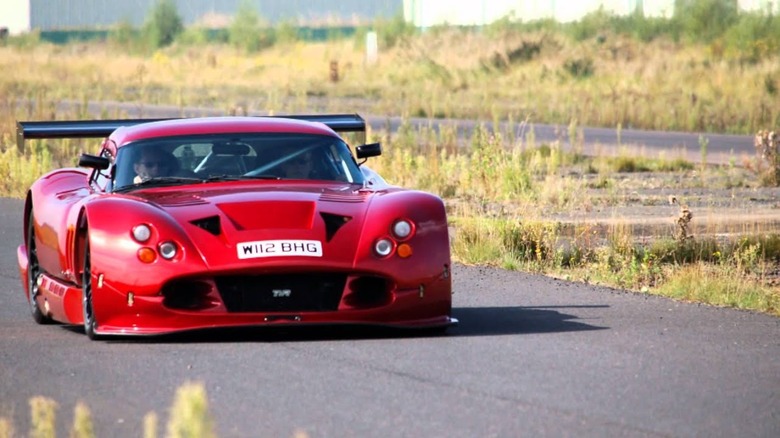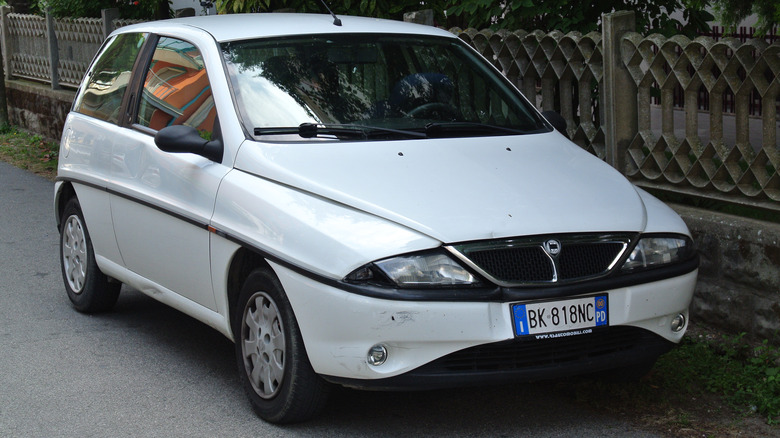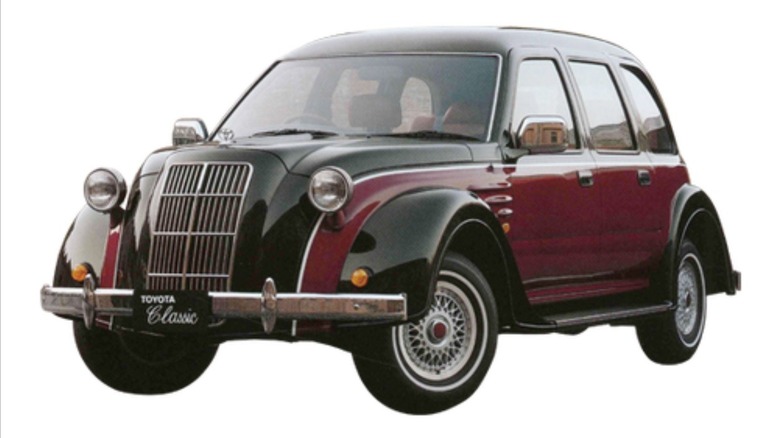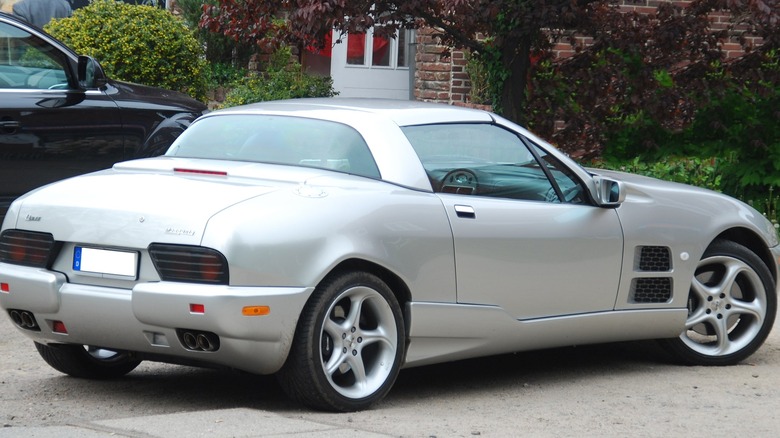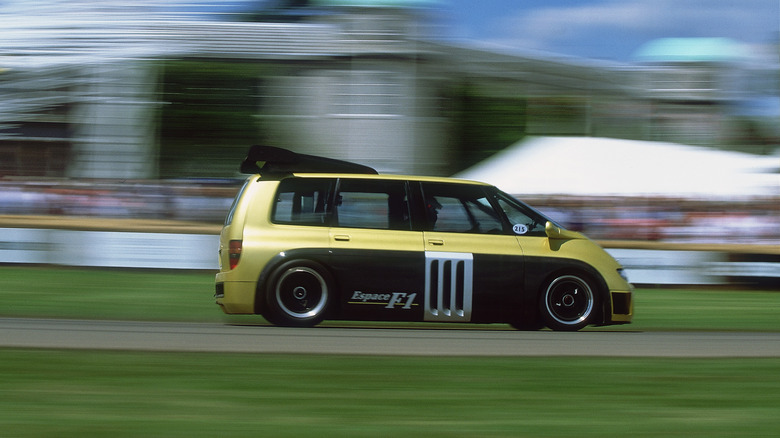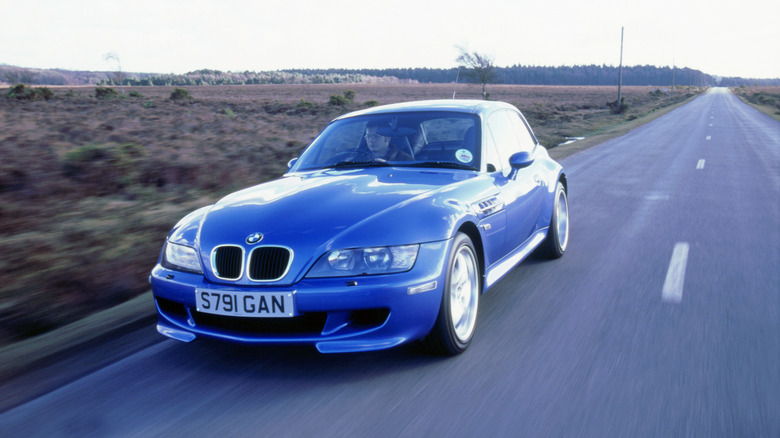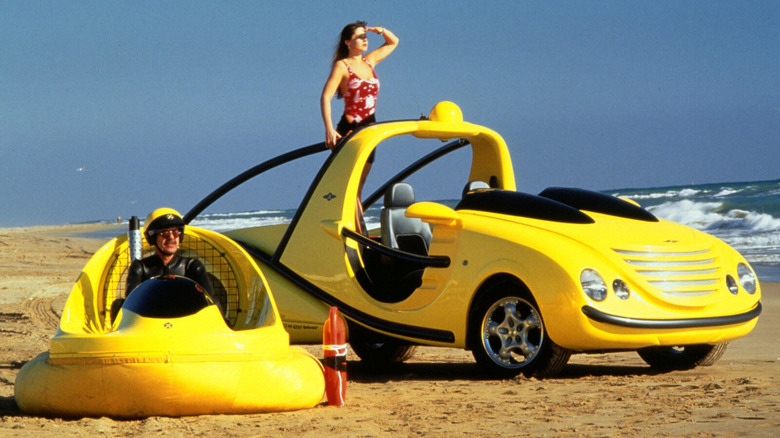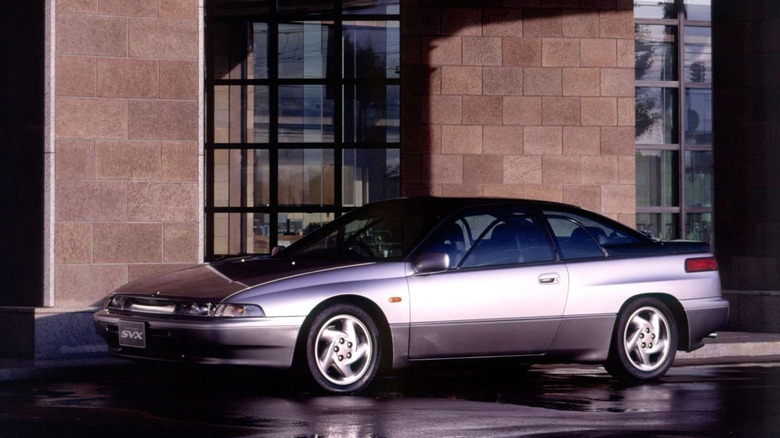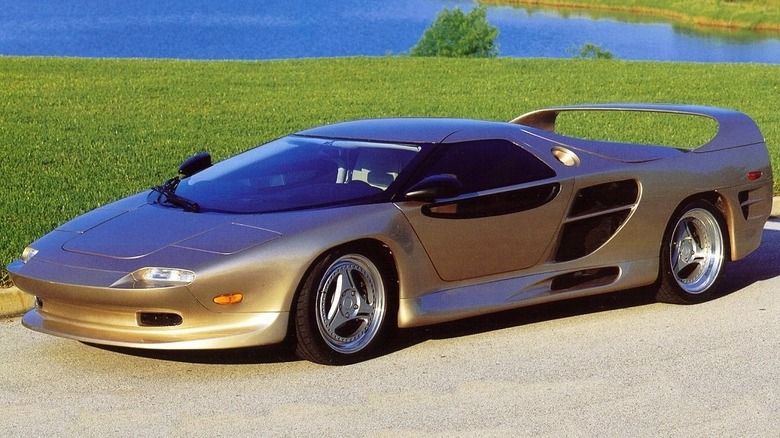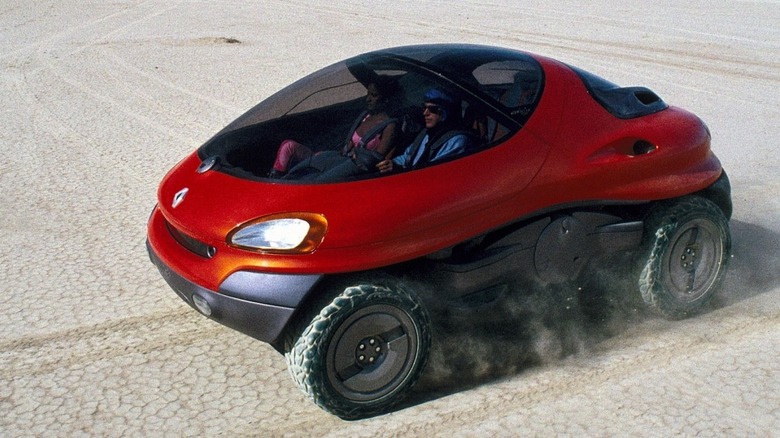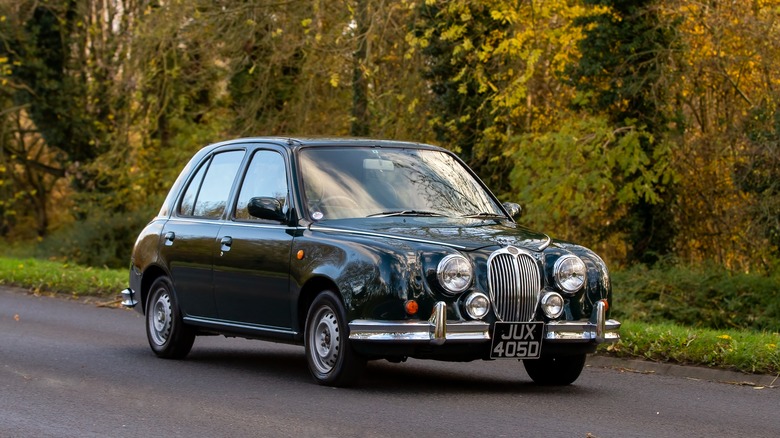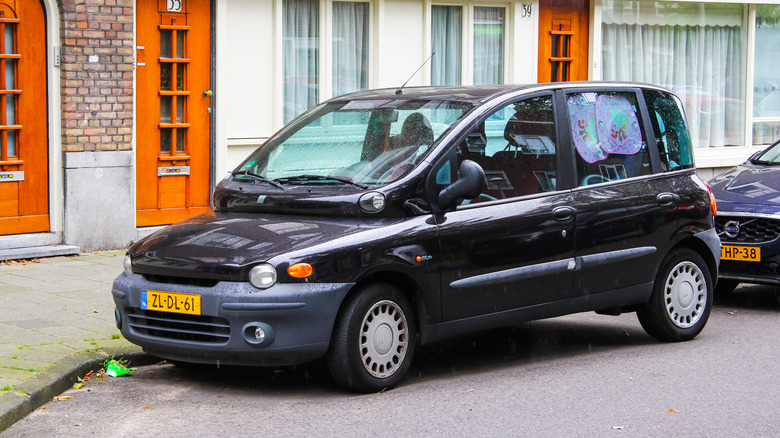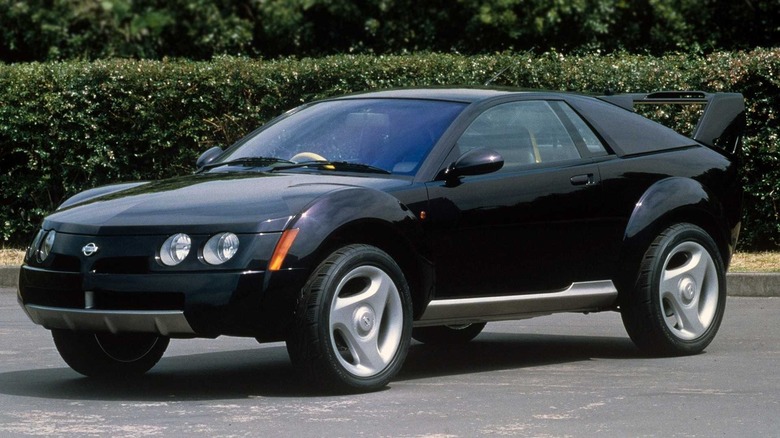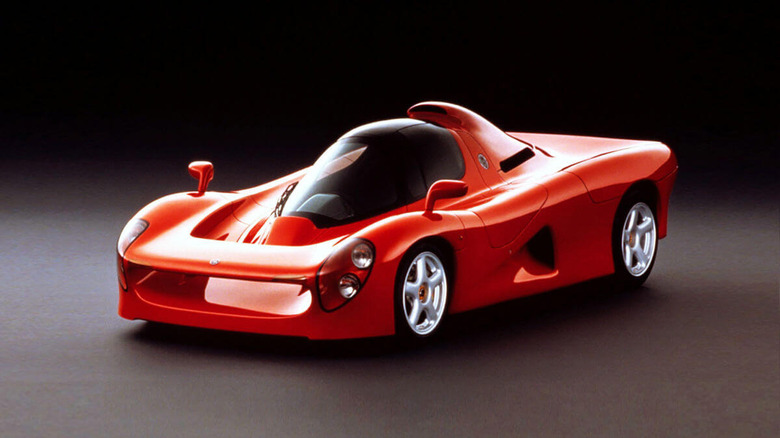90s Cars That Had Us Scratching Our Heads
The '90s were a transformative decade for the automotive industry, with many of the period's biggest innovations going on to shape the modern car market. The McLaren F1 was unveiled in 1992 and heralded a new era of hypercar, while on the other end of the spectrum, the launch of the first Smart Coupe in 1998 revolutionized the idea of what a supermini could be. The end of the decade also saw the launch of the BMW X5, a pioneering model that paved the way for the luxury SUVs that are everywhere in today's car market.
But, for every roaring success that the '90s brought, there were plenty of cars from the era that didn't go down so well. Some of them only made it to the concept stage, but plenty made it to production, and some even sold in impressive numbers. But, all of them are united by the fact that they are fundamentally weird ideas, curious byproducts of a time of intense innovation from the world's biggest automakers. These '90s cars all left us scratching our heads.
TVR Cerbera Speed 12
In the mid-'90s, British performance automaker TVR embarked on its most ambitious project yet: to build the world's fastest car. Called the Speed 12, the car would be based on the brand's existing Cerbera sports car, but it would feature a mighty V12 engine with a target output of 1,000 horsepower. The car debuted in concept form in 1996 and development continued throughout the latter part of the decade. The plan was for TVR to develop a racing version for entry into the 24 Hours of Le Mans, although this never happened.
As the decade drew to a close, hype around the car increased, and deposits were reportedly taken for the Speed 12. However, after personally testing a prototype version of the car, company owner Peter Wheeler decided it was simply too powerful for the road, and axed the project before any production versions could be delivered. One road-legal example was eventually completed in 2003 and sold to a collector who was personally approved by Wheeler. The Speed 12's cancellation was a sign of financial troubles ahead. Just a few years after the project was axed, TVR would run out of cash, eventually declaring bankruptcy in 2006.
Lancia Ypsilon
The late '80s and early '90s were a great time for Lancia, with the company basking in its success in the World Rally Championship, winning four out of five driver's titles between 1987 and 1991. But, by 1995, things had turned sour, as the automaker was trying to deal with a drop in sales numbers and dwindling profits. Its response was to launch the Ypsilon, a very uninspiring economy hatchback that was one of the brand's ugliest designs in years. The Ypsilon came with a range of paltry engines, from a base-spec 53 horsepower 1.1L to a top-spec 1.4L making just 85 horsepower.
Although the Ypsilon sold fairly well across Europe, it reinforced Lancia's newfound reputation as a manufacturer of dull cars. Lancia's image never recovered, and today the brand is only sold in its native Italy. Only one car is available in the 2022 lineup, ironically also called the Ypsilon. However, parent company Stellantis is planning to relaunch Lancia across Europe in the next few years.
Toyota Classic
One of the strangest production Toyotas from the era doesn't look like it was made in the '90s at all. The ultra-rare Toyota Classic was designed to pay homage to the company's first passenger vehicle, the AA. Just 100 examples of the classic were made in 1996, each one based on the chassis of a Toyota Hilux pickup truck. The Classic also shares its doors and many of its internal components with the Hilux, and its engine was borrowed from the Hilux Surf.
Inside, the Classic was an odd combination of the standard work-ready Hilux interior with upholstery that looked right out of a high-end Lexus. The seats and door liners were made from leather, and generous lashings of woodgrain were applied throughout the car for a retro look. The Truth About Cars reports that Toyota's asking price for the Classic was the equivalent of around $143,000 today, but all 100 units sold. It's unclear whether any examples have made their way to the U.S. as they have become legal to import under the 25-year rule from 2021.
Qvale Mangusta
The Qvale Mangusta was first shown off to the public in 1996 as the De Tomaso Biguá. It was intended to be the comeback car for the struggling De Tomaso brand, but most of the car's development had to be financed by an American investor, Bruce Qvale. After De Tomaso abandoned the project, Qvale decided to rebadge the car under his own name, and the Mangusta was born. Production commenced in 1999 and over the following three years, Top Gear reports that a total of 284 examples of the car were built.
Despite its unique looks that were penned by none other than Marcello Gandini, the car's driving experience would feel very familiar to anyone with a working knowledge of American muscle cars. That's because the Mangusta featured a bone-stock V8 from a Ford SVT Mustang Cobra under the hood, and it also shared the Mustang's steering column, fuel system, and interior gauges. The Mangusta's many shared parts meant that it felt a lot like a Mustang to drive, despite it being $50,000 more expensive. Used prices for the car quickly tanked, and today, Mangustas can be picked up for less than $30,000.
Renault Espace F1
One of the most gloriously absurd '90s cars of all, the Renault Espace F1 answered a question no one had asked: What happens when you combine an aging minivan with a Formula 1 car? Renault enlisted the help of the Williams F1 team, fresh off the success of their 1992 and 1993 Championships. The car was built on a custom carbon fiber chassis, part of which was copied directly from the 1993 Williams F1 car. Power also came courtesy of the F1 team, with a Williams-Renault V10 mounted in the middle of the car for optimal weight distribution. It produced around 800 horsepower and was capable of revving past 13,000 rpm.
Only one example of the Espace F1 was produced, and Renault only let its own test drivers have a go behind the wheel. Thanks to its unusual aerodynamics, the car was reportedly very difficult to control at speed. The car currently resides in the Matra Museum in France, although a second, non-functional version of the car is kept in Renault's official collection.
BMW Z3 M Coupe
Although it's arguably one of BMW's ugliest designs of the era, the BMW Z3 M Coupe has gained a cult following in the decades since its release. Nicknamed the "clown shoe" because of its comically odd shape, the M Coupe nearly didn't make it to production, as executives were reportedly concerned about its appearance. But, the story goes, after they drove it, they were convinced to sign off on a limited production run of the car.
The M Coupe was powered by a 317 horsepower straight-six engine that was borrowed from the E36 M3 Evolution, and the car was considerably lower and stiffer than a standard Z3. It wasn't the fastest car in a straight line, but its lack of driver aids and back-to-basics construction meant that it was a blast to drive. However, buyers were put off by the car's strange looks and high asking price, and in total, only 6,291 examples were ever produced.
Rinspeed X-Trem MUV
Boutique Swiss automaker Rinspeed has a history of coming up with wacky concept designs, but the 1999 X-Trem MUV has to be one of its weirdest. Rinspeed called the car a Multi-Utility Vehicle, claiming that the concept was inspired by the popularity of the pickup truck in America. According to its press release, Rinspeed thought that too many Americans drove around with the beds of their pickups empty most of the time. So, the X-Trem's novel solution was to make the bed much lower and easier to access than a standard pickup.
This enabled the X-Trem to transport larger items like motorcycles, which seems like a good, sensible idea. But, this is a Rinspeed concept, so it also came with a miniature crane in the bed, and a complimentary mini hovercraft for some reason. Not to mention, it's one of the weirdest exterior designs of any pickup, full stop. Needless to say, the car never made it to production, like most of the company's designs.
Subaru SVX
Throughout the '80s, Subaru established itself as a reputable maker of hard-wearing economy cars and rally machines, but it had yet to prove that it could compete in the luxury segment. Launched in 1992, the SVX was designed from a blank slate as a luxury coupe to compete with the likes of the Jaguar XJS and Audi Coupe S2. The first thing to note about the car is its unusual design: penned by Giugiaro, the SVX is unlike anything else from the era. But, its window-within-a-window look put off some buyers, and its black roof never managed to convincingly pull off the illusion that the car had an unbroken dome of glass as intended.
Just over 24,000 units were sold across its lifetime. Thanks to high development costs, Subaru lost money on each one. Today, the remaining SVX survivors are rare, but examples are on the market for around $10,000. It might have been attractively priced and filled with cutting-edge tech, but the SVX's oddball appearance and mediocre performance ensured that it never made the impact Subaru hoped it would.
Isuzu Vehicross
Continuing the theme of oddly-designed Japanese cars, the Isuzu Vehicross remains one of the most unusual-looking SUVs. It was designed as a low-volume special that borrowed much of its internals from the dull-but-capable Isuzu Trooper. Its 3.5L V6 engine was carried over from the Trooper and made 215 horsepower and 230 lb-ft of torque. Tests of the Vehicross from the era revealed that it was a thoroughly capable off-roader, but it was also one of the sportiest SUVs on the market, in many ways foreshadowing the performance SUV craze that would materialize a decade or so later.
The Isuzu's weird looks and limited interior space limited its appeal, and the company only managed to sell 5,958 examples across the three years that it was on sale. It seems that Isuzu nearly managed to get the formula right, as the combination of off-road capability and sporty performance is one that always sells well in today's market. But, the Vehicross suffers from too many design oddities, like the spare wheel that was only accessible from inside the rear tailgate, and the prominent plastic paneling that went out of fashion almost as soon as the SUV was launched.
Vector M12
Vector was first formed by American engineer Gerald Wiegert in 1971 under the name Vehicle Design Force, and the company spent most of the '70s and '80s showing off prototypes that never actually led to production cars. By the early 1990s, an Indonesian company called MegaTech had launched a hostile takeover of the firm, eventually convincing the courts to let them take control of the company away from Wiegert. The first car produced under this new ownership was the M12, which was heavily based on a car from MegaTech's other subsidiary, Lamborghini. The M12 borrowed its engine, chassis, and many of its internal parts from the Diablo, although it was inexplicably slower than the Diablo, both in its acceleration and top speed.
In addition to the parts borrowed from Lamborghini, Car Throttle reports that some of the interior trim was borrowed from a humble Ford Taurus. Perhaps the biggest issue was that the M12 was the opposite of what Vector had been promising for years. Pre-takeover, Vector had always emphasized that its cars were all-American, with American design and American parts. But now, here was a re-bodied Italian supercar with economy car trim and a Vector badge. The company only managed to sell a total of 17 vehicles before running out of cash, with Lamborghini eventually being sold off to Audi and the Vector name being bought back by Wiegert at a bankruptcy auction.
Renault Racoon
French automaker Renault has always been known for its outlandish concepts, a trend that it has continued up to the present day. One of its most unique concepts from the '90s is the Racoon, a V6-powered amphibious car that looks like a cross between a moon buggy and an SUV. The Racoon's weird looks were designed to draw attention to its cutting-edge technological features, many of which have become commonplace on today's cars. It featured remote central locking, rear-view cameras, and satellite navigation, all of which were in their infancy when the concept was unveiled in 1992.
As well as traveling on land, the car was capable of speeds of up to 5 knots in the water. The cabin was only accessible via the roof, which could be lifted as a single piece to allow the driver to fit underneath. Since the car was only ever intended to be a tech demo, no road-legal examples were ever produced. It's not clear what happened to the concept car after it left the auto show circuit, as it hasn't been seen in public.
Mitsuoka Viewt
One of the most baffling carmakers to emerge from Japan, Mitsuoka specializes in making weird-looking coachbuilt cars in low numbers. Its signature model is the Viewt, the first generation of which was launched in 1993. It was based on the Nissan March, also known as the Micra, but featured unique bodywork that borrowed heavily from the classic Jaguar MkII. It kept the same powertrain and interior as the regular March, which helped keep costs down compared to other coachbuilt cars. According to AllJapaneseMotors, over 12,000 examples of the Viewt have been sold across three generations.
Earlier examples of the Viewt can now be imported to the U.S. under the 25-year rule. Its design is an acquired taste, to say the least, but it's certainly unique. As odd as it may be that buyers would be willing to pay a premium for a classic Jag-inspired supermini, Mitsuoka has a cult following in Japan, and also across the world in export markets like the UK and Europe.
Fiat Multipla
Minivans aren't usually known for divisive styling, but the Fiat Multipla is a little different from the rest. Launched in 1998, the car featured a distinctive two-step design at the front, with the headlights split across two levels. It's not entirely clear why Fiat chose such an unusual look, especially since the rest of the car is pretty much standard minivan fare. It certainly caused a stir when it launched, so much so that it was even displayed at the Museum of Modern Art in New York as part of its "Different Roads – Automobiles for the Next Century" exhibition in 1999.
Its design might have made it a museum-worthy oddity, but its sales numbers were surprisingly strong for such an unusual-looking car. Between 1998 and 2004, the first generation Multipla sold over 212,000 units in Europe, although sadly, it was never offered for sale in North America. Anyone interested in importing one will be able to do so from 2023 when the first examples turn 25 years old.
Nissan Trail Runner
One of the coolest forgotten concepts from the '90s has to be the Nissan Trail Runner, a sporty crossover that's part rally car and part sport SUV. It featured a 1.8L engine making 185 horsepower, a respectable figure for the era, and it came with an all-wheel drive system borrowed from the Skyline GT-R. Its high ground clearance and beefy tires gave it genuine all-terrain capabilities, yet it still looked like a sports car, more so than many of today's sporty crossovers do.
The car premiered at the Tokyo Motor Show in 1997, but Nissan reportedly decided that bringing the car to production was too much of a risk, as there wasn't anything else like it on the market. The idea of a production off-road sports car never gained much traction until 2022, when Lamborghini announced an all-terrain variant of its Huracan supercar, called the Sterrato. Not much is known about the car yet, but it seems like finally, the idea of a rally-spec sports car might become a production reality. Unfortunately, it's too late for the Trail Runner, which disappeared back into Nissan's storage facilities and hasn't been seen since it left the auto show circuit.
Yamaha OX99-11
In celebration of its role as a Formula 1 engine supplier, Yamaha decided to make its own track-ready supercar in the early '90s. The OX99-11 was first unveiled in 1992, and it featured a detuned version of Yamaha's F1 V12, making around 400 horsepower. The engine was mated to a six-speed manual transmission and power was sent through the rear wheels only. So, in other words, this was the ultimate purists' car. The car featured a central seating position for the driver, much like the McLaren F1, and liberal use of carbon fiber kept the car's weight down to just 2,535 lbs.
An eye-watering price tag of $1 million was set for the car, but before it could reach production, Yamaha ran out of cash, and the project was axed. The development phase of the OX99-11 coincided with the Japanese economic crash, and so it was decided that it simply wasn't feasible to continue with making an ultra-expensive supercar when things were so dire at home. Three prototypes were produced before the project got pulled, and all three survive to the present day, reports Evo. One example went up for sale in 2020, with a price tag of $1.3 million, a reasonable price to pay for such a unique piece of Japanese automotive history.
